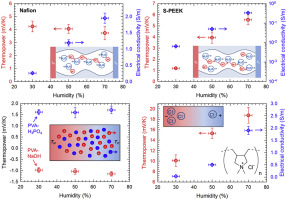Organic Electronics ( IF 2.7 ) Pub Date : 2017-12-18 , DOI: 10.1016/j.orgel.2017.12.021 Suk Lae Kim , Jui-Hung Hsu , Choongho Yu

|
Solid-state polyelectrolytes have recently been reported to exhibit extremely high thermally induced voltage in contrast to conventional thermoelectric materials, showing great promise in energy harvesting for wearable and flexible electronics. Nevertheless the thermoelectric behaviors of polyelectrolytes have been barely studied. Here we provide comparative experimental studies about the thermoelectric behaviors of three different types of solid-state polyelectrolytes - cation conductors with negatively charged immobile backbones (Nafion and S-PEEK), conductors with both cations and anions (basic PVA-NaOH and acidic PVA-H3PO4), and an anion conductor (PDDAC). We observed that the proton conductors (Nafion and S-PEEK) exhibited large thermopower values up to ∼5.5 mV/K. Higher humidity rendered the thermopower of S-PEEK larger but that of Nafion smaller, which is attributed to the opposite thermo-diffusion direction of water. When both cation and anion are thermally diffused (PVA-NaOH and PVA-H3PO4), the absolute values of thermopower was relatively small 1–1.5 mV/K and independent of humidity. In PDDAC, we observed extremely large thermopower values up to 19 mV/K, which could be attributed to more rigorous dissociation of Cl− in the hotter side rather than the thermo-diffusion of Cl−. Our experimental results provide useful data for developing practical thermal energy harvesters and storage devices with high output voltages for wearable and flexible electronic devices.
中文翻译:

固态聚电解质中的热电效应
与传统的热电材料相比,最近已报道固态聚电解质表现出极高的热感应电压,在可穿戴和柔性电子产品的能量收集中显示出巨大的希望。然而,几乎没有研究聚电解质的热电行为。在这里,我们提供了三种不同类型的固态聚电解质的热电性能的对比实验研究-带有带负电的固定主链的阳离子导体(Nafion和S-PEEK),带有阳离子和阴离子的导体(碱性PVA-NaOH和酸性PVA-高3 PO 4)和阴离子导体(PDDAC)。我们观察到质子导体(Nafion和S-PEEK)显示出高达5.5 mV / K的大热功率值。较高的湿度使S-PEEK的热功率变大,而Nafion的热功率变小,这归因于水的相反热扩散方向。当阳离子和阴离子都进行热扩散(PVA-NaOH和PVA-H 3 PO 4)时,热功率的绝对值相对较小,为1–1.5 mV / K,并且不受湿度影响。在PDDAC,我们观察到非常大的热电动势值高达19毫伏/ K,这可以归因于的Cl更严格的解离-在较热侧,而不是Cl组成的热扩散-。我们的实验结果为开发实用的热能采集器和具有高输出电压的可穿戴和柔性电子设备的存储设备提供了有用的数据。











































 京公网安备 11010802027423号
京公网安备 11010802027423号